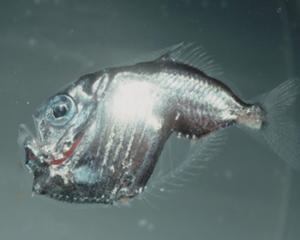Five hundred metres down, and in even the clearest tropical waters only the faintest vestige of the sunlight remains, so little that our eyes can't detect it ... but others can.
水深五百公尺,在这里就连最清澈的热带海域也只剩下最微弱的光亮,光线是如此微弱,我们的肉眼也无法查觉,但是其他生物却可以。
Survival in the twilight zone is all about seeing, yet not being seen.
微明区的生存取决于看见与不被看见中间。
Hatchet fish are masters of the game of hide and seek.
棘银斧鱼是捉迷藏的专家。
They have the large, sensitive eyes needed for seeking prey, but their bodies are flat. And their sides are highly silvered.
它们有对敏锐的大眼睛,可以侦测猎物的存在,但它们的身体却是扁平的。两侧的身体闪着银光。
Head on, they are just visible, thin though they are,
正对面时,它们是清楚可见的,
but as soon as they turn, their mirrored sides reflect the remnants of blue light from the surface and they disappear into the gloom.
但就在它转身之后,它们的身侧会像镜子一样反射出来自海面的微弱蓝光,就这么消失在微亮中。
Viewed from the side, whole shoals can hide in this way. But what about from below?

The tubular eyes of many of the predators even in this gloom are able to distinguish their prey, silhouetted against the scarcely detectable glimmer of light from above.
许多猎食者管状的眼睛可以在微弱的光亮中辨识猎物微弱日光下的剪影。
Hatchet fish, however, have a way of confusing any eyes that might be searching for them from below.
棘银斧鱼有办法骗过任何在它们身下搜寻的眼睛。
Their bellies carry rows of light-producing cells called photophores.
它们在腹部有种会发光的细胞,称作发光器官。
They can use these to exactly match the changing colour of light from the surface far above.
它们利用发光器官制造出与水面透下的天光相仿的颜色。
This counter shading breaks up their silhouette, making them almost invisible from below... almost.
这项反影装置破坏了它们的剪影,从下面看上来几乎无法发现它们的踪影,只是'几乎'而已。
But these are no ordinary eyes. The enormous yellow lenses enable their owner to distinguish between light produced by photophores and sunlight.
但是这对眼睛绝不寻常。这对巨大的黄色眼镜让它们的所有人可以清楚辨认自然的天光及发光器官所制造出来的光。
So, one device for escape is countered by another equally subtle one for attack in an evolutionary arms race that has been waged for millions of years.
在持续千百万年的演化竞赛中为了逃命而演化出的装置被另一项猎食装置破解。












